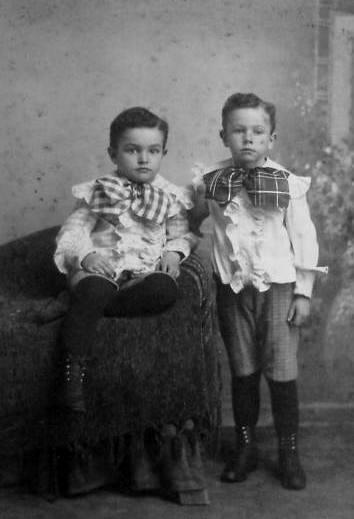
Figure 1.--These brothers look to be about 3-5 years olds They wear fancy Fauntleroy blouses with large floppy bows. The portrait is undated, but was probably taken about 1890. The studio was Stickey in Oneida, New York. |

|
Floppy bows for boys in the late-19th and early-20th century was along with hugh frilly collars ther most decorztive features of Litle Lord Fauntleroy stylinge. The bows could be huge. And size was part of the Fautleroy Craze. The larger bows were used for the youngest boys. The bows were were seen a distinctly juvenile style. For this reason they were used by mothers for what was called 'age grading'. Large bows ere not, however, just worn by very little boys--although the lrgest bows were. While they were commonly worn by younger boys, they were not exclusively for very young boys. At the peak of the Fanntleroy Craze we see boys even younger teens wearing them. The age of the boys wearing floppy bows varied over time. We se boys of all ages wearing them, ending for some boys only after the early teens. HBC has archived hundreds of photographs of pre-scool and school age boys wearing them, mostly in the late 19th century. We note 4-year old Gordon Bently wearing a simple flat bow in 1879. We note Bert Dodge wearing a floppy bow at about age 3 in the 1880s. We note Harold Howes at age 5 years wearing a moderate-sized bow with an Eton collar and tunic suit in 1905. Another example is Charles Dorff who looks to be about 8-years old about 1905. And we see Percy Jackman wearing a floppy bow at age 10 in 1899. We also note younger teenagers wearing them. We see some 13-year olds and a few 14-year olds wearing them. Youngr teenagers wearing floppy bows became less common after the turn of the 20th century. We still see them in the early 1900s, buy after about 1905 they begin to declie in popukarity. And the age of boys wearing them as well as the overall popularity of this fashion gradually declined.
Mothers in the late-19th and early-20th century commonly used age grading in selecting clothing for children. This was a practice that was prevlent begoe abd after, but particularly string surung this peiod, and especially notable during the Fauntleroy Craze era. It involved garments such as hair stylng, headwear, shirts/blouses, neckwear, collars, jacketss, pants, hosiery, and shoes. These were decisions largely made by mother and varied drom family to family. And there were variations concerning hair styling and the various garments involved. Floppy bows for boys in the late-19th and early-20th century were along with huge frilly collars the most decorative features of Little Lord Fauntleroy stylinge. The bow could be huge. And size was part of the Fauntleroy Craze. The larger bows were used for the youngest boys. The bows were were seen a distinctly juvenile style. For this reason they were used by mothers for what was called 'age grading'. Large bows were not, however, just worn by very little boys--although the largest bows were. While they were commonly worn by younger boys, they were not exclusively for very young boys. At the peak of the Funntleroy Craze we see boys evn younger teens wearing them.
The age of the boys wearing floppy bows varied over time, excpecially after the late-1890s. This is a little difficult to assess because most period images are undated andwe re discussing a relatively short period, anout 1885-1905. The bow appear a little befire that and continue a little after tht. For the most part the really lrge boes appear during the Craze period. . .
We see boys of all ages wearing flopping bows. This began wih tidlers at abiut 2-3 years of age. They were commonly through thev primary svhool asges. But prevalence for school-age boys gradually decline sfter sbout g 210 years as fvid thecxsize vof ythe boes. They dfisapear for boys, however, only after the early teens. HBC has archived hundreds of photographs of pre-scool and school age boys wearing them, mostly in the late 19th century. We note 4-year old Gordon Bently wearing a simple flat bow in 1879. We note Bert Dodge wearing a floppy bow at about age 3 in the 1880s. We note Harold Howes at age 5 years wearing a moderate-sized bow with an Eton collar and tunic suit in 1905. Another example is Charles Dorff who looks to be about 8-years old about 1905. And we see Percy Jackman wearing a floppy bow at age 10 in 1899. We also note younger teenagers wearing them. We see some 13-year olds and a few 14-year olds wearing them. Youngr teenagers wearing floppy bows became less common after the turn of the 20th century. We still see them in the early 1900s, buy after about 1905 they begin to declie in popukarity. And the age of boys wearing them as well as the overall popularity of this fashion gradually declined.
Navigate the Boys' Historical Clothing Web Site:
[Return to the Main U.S. floppy bow page]
[Return to the Main floppy bow country page]
[Return to the Main U.S. country garment page]
[Introduction]
[Activities]
[Biographies]
[Chronology]
[Clothing styles]
[Countries]
[Bibliographies]
[Contributions]
[FAQs]
[Glossary]
[Images]
[Links]
[Registration]
[Tools]
[Boys' Clothing Home]
